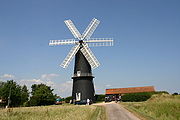
Sibsey Trader Mill
Encyclopedia

Sibsey
Sibsey is a civil parish and village on the A16 road and B1184 in the English county of Lincolnshire, north of Boston in the district of East Lindsey. At the 2001 census, it had a population of 1,996. Sibsey Northlands is to the north of the village...
, Lincolnshire
Lincolnshire
Lincolnshire is a county in the east of England. It borders Norfolk to the south east, Cambridgeshire to the south, Rutland to the south west, Leicestershire and Nottinghamshire to the west, South Yorkshire to the north west, and the East Riding of Yorkshire to the north. It also borders...
. It one of two windmill
Windmill
A windmill is a machine which converts the energy of wind into rotational energy by means of vanes called sails or blades. Originally windmills were developed for milling grain for food production. In the course of history the windmill was adapted to many other industrial uses. An important...
s which were grinding flour for the local community. Rhodes Mill (the second of the two) has been converted into a house. Built in 1877 by Saunderson of Louth
Louth, Lincolnshire
Louth is a market town and civil parish within the East Lindsey district of Lincolnshire, England.-Geography:Known as the "capital of the Lincolnshire Wolds", it is situated where the ancient trackway Barton Street crosses the River Lud, and has a total resident population of 15,930.The Greenwich...
in the typical Lincolnshire style, since then it has been restored and is now owned by English Heritage
English Heritage
English Heritage . is an executive non-departmental public body of the British Government sponsored by the Department for Culture, Media and Sport...
and managed by an independent party. It is a six storey windmill with complete gear, six sails and fantail which still works today. It is a Grade I listed building.
The windmill is one of the very few six-sailed mills still remaining in England.
The mill itself is not exceptionally tall and in fact stands only six floors high above ground and the height to the top of the mill's cap is a mere 74 feet 3 inches. However the slenderness of the tower combined with the flat landscape which surrounds the mill give the illusion that Sibsey is larger than it actually is. The slim central tower also makes the sails look enormous in comparison.
The mill worked until 1954 (although with only four sails in its later years) following which it was allowed to fall into disrepair. It has now been restored to full working order and today produces a wide range of organic flours.
External links
- Sibsey Trader Mill page on English Heritage site
- Official website of Sibsey Trader Windmill
- Page at Geograph with several images
- Sibsey Trader Windmill - unofficial website

